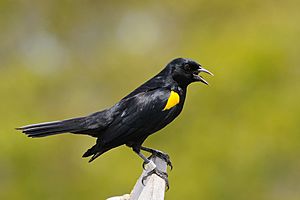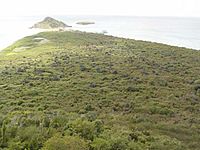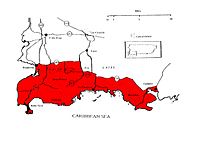Yellow-shouldered blackbird facts for kids
Quick facts for kids Yellow-shouldered blackbird |
|
|---|---|
 |
|
| Conservation status | |
| Scientific classification | |
| Genus: |
Agelaius
|
| Species: |
xanthomus
|
| Subspecies | |
|
A. x. monensis Barnes Jr, 1945 |
|
| Synonyms | |
|
Icterus xanthomus |
|
The yellow-shouldered blackbird (Agelaius xanthomus) is a special bird. It is also known as la Mariquita de Puerto Rico or capitán. This blackbird is found only in Puerto Rico. It belongs to a group of birds called Icteridae. The bird is mostly black with a bright yellow patch on its wings, near its "shoulders." Both male and female birds look very similar. They mostly eat insects.
Contents
About the Yellow-shouldered Blackbird
The yellow-shouldered blackbird was first described in 1862. This happened in Puerto Rico and Vieques. It was named Icterus xanthomus by Philip Sclater. This bird is closely related to the red-winged blackbird. Some people used to think it was a type of tawny-shouldered blackbird. That bird lives in Cuba and Haiti. The main difference is that the tawny-shouldered blackbird has a wider bill. There is also a special type of yellow-shouldered blackbird. It is called the Mona yellow-shouldered blackbird (A. x. monensis). It lives on the islands of Mona and Monito.
What Does the Yellow-shouldered Blackbird Look Like?
As its name tells you, the yellow-shouldered blackbird is a shiny black bird. It has a small yellow patch on its "shoulders." This patch has a white edge. Young birds are not as bright. Their bellies are brown. Male and female birds have the same colors. But males are bigger than females.
Adult birds are about 20 to 23 centimeters (8 to 9 inches) long. Males usually weigh about 41 grams (1.4 ounces). Females weigh about 35 grams (1.2 ounces). Males also have longer wings. Their wings are about 102 centimeters (40 inches) long. Females' wings are about 93.3 centimeters (36.7 inches) long.
Where Do Yellow-shouldered Blackbirds Live?

These birds used to live all over the coastal forests of Puerto Rico. But in the early 1900s, many forests were cut down. This made space for sugarcane farms. Later, when the sugar industry declined, houses were built.
Now, these birds live in only three main areas. They are found on Mona and Monito. A special type of the bird lives there. They also live near the Roosevelt Roads Naval Station in eastern Puerto Rico. And they live in the dry forests and mangroves in southern Puerto Rico. These places are mostly dry coastal forests. But sometimes, the birds fly inland. They have been seen in the mountain town of Lares. They also visit wet forests when it's not breeding season.
The number of these birds dropped a lot from the 1970s to the 1980s. This was because their homes were destroyed. Also, another bird, the shiny cowbird, laid its eggs in their nests. This is called brood parasitism. In 1976, there were about 2000 yellow-shouldered blackbirds. By 1982, there were only about 300. But thanks to conservation efforts, their numbers have grown. Now there are about 1250 pairs.
The birds on Mona Island were about 200 in 1976. Later studies showed between 220 and 400 birds. Birds also travel from Mona to Monito Island. Monito is about 5 kilometers (3 miles) away.
Yellow-shouldered blackbirds do not migrate. But some birds move from the coast to inland areas. They do this during the non-breeding season to find food.
What Do Yellow-shouldered Blackbirds Eat?
Yellow-shouldered blackbirds eat both plants and animals. This means they are omnivores. But they mainly eat insects. So they are considered insect eaters.
Scientists studied what these birds eat. They looked at food parents brought to their babies. They found insects like butterflies, grasshoppers, and beetles. They also found spiders and snails. Sometimes, they eat plant matter. They also eat human food like cooked rice and sugar. They even eat dog food and monkey chow. They find insects by picking them off trees. During nesting season, 90% of their diet is insects and spiders.
On Mona Island, the birds eat insects and spiders too. They also eat fruits from certain plants. These include Pithecellobium and different types of cacti. They eat seeds from gumbo limbo trees and fig trees. They also drink nectar from plants like Aloe vera and yucca.
Reproduction and Life Cycle
The yellow-shouldered blackbird's breeding season usually runs from April to August. But they can breed from February to November. The breeding season starts when the rainy season begins.
These birds are believed to mate for life. They usually try to nest once a year. They often nest in small groups. Both the main type and the Mona type of blackbird lay one to four eggs. They usually lay three eggs. The eggs are blue-green with brown spots. The female bird sits on the eggs for 13 days. Both male and female birds can start having babies when they are one year old.
Like other Agelaius birds, they build open, cup-shaped nests in trees. But where they build nests can change. It depends on where they live and what materials are available. Birds at Roosevelt Roads build nests in hollows of dead mangroves. The Mona birds build nests on ledges or cracks in coastal cliffs. They use eight different types of places to nest. These include mudflats, mangrove islands, dry coastal forests, and suburban areas. They also nest in coconut farms and on coastal cliffs.
Only the female builds the nest. Both parents feed the young birds. Baby birds leave the nest 13 to 16 days after hatching. Males protect a small area around the nest. This area is about 3 meters (10 feet) wide. They do this to keep other males away.
Yellow-shouldered blackbirds also do something called anting. This is rare. It means they rub ants on their bodies and feathers. They do this for a short time, about 8 minutes.
These birds also show mobbing behavior. This is when a group of birds attacks a known predator. They do this to protect their eggs or babies.
Threats and Conservation Efforts
The yellow-shouldered blackbird was listed as an endangered species on November 19, 1976. This means it is at risk of disappearing forever. Special protected areas were set up for them. These include all of Mona and Monito islands. Also, the Roosevelt Roads Naval Station in Ceiba. And an area from Cabo Rojo to Guánica in southwest Puerto Rico. A small area in San Germán is also protected.
Diseases can harm these birds. One type of parasite found on them is the chewing louse. Three types of these lice have been seen. They mostly live on the birds' heads. Adult males have the most lice. Young birds have fewer. Mites have also been found in nests. But they do not seem to be a big threat. Another disease is fowlpox. This causes sores on their legs and wings.
Predators eating their nests has also caused their numbers to drop. Rats, mongooses, and wild cats are known predators. These animals were brought to Puerto Rico by humans. Rats are a big problem. They eat both eggs and baby birds. In 1983, rats caused 48% of nest failures. This happened when water levels dropped, making mangrove nesting areas easy to reach.
Since the mid-1980s, people have built special nests for them. These are made of PVC pipes. They are placed in mudflats near mangrove forests. This helps protect the nests from rats. The birds liked these new nests. Now, very few natural nests are seen in the area.
Losing their feeding and breeding places is a big threat. Also, the shiny cowbird laying eggs in their nests hurts them. Natural predators like the pearly-eyed thrasher also cause some problems. These birds steal eggs and young. They also destroy nests.
Images for kids
See also
 In Spanish: Mariquita de Puerto Rico para niños
In Spanish: Mariquita de Puerto Rico para niños




